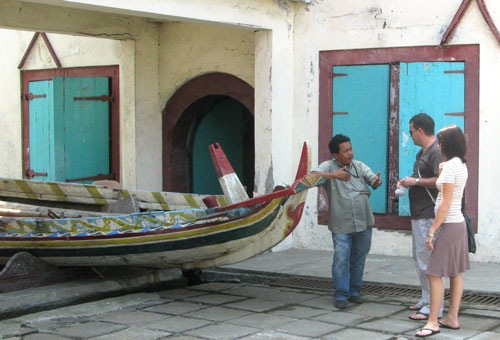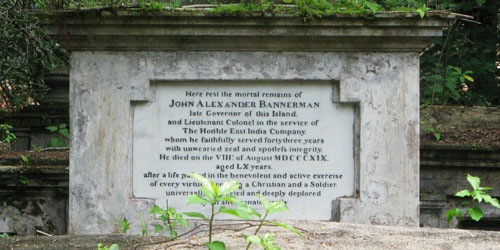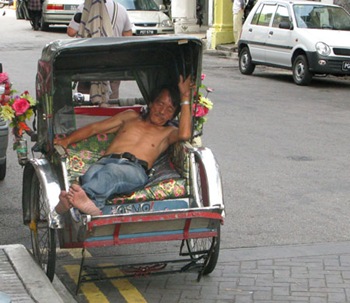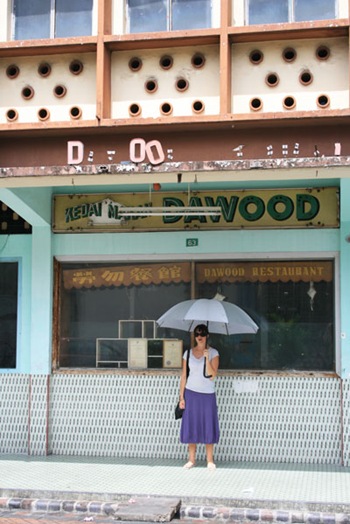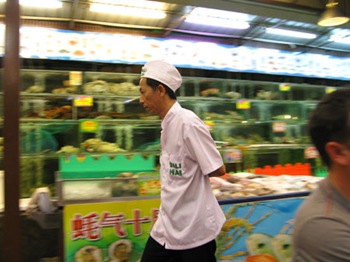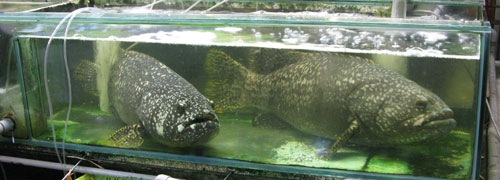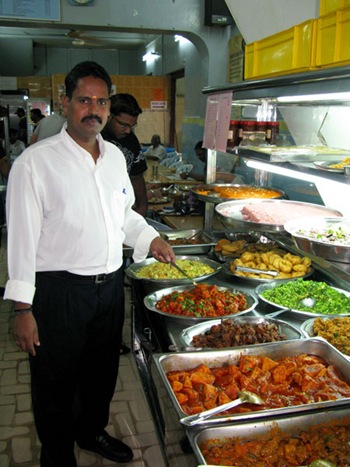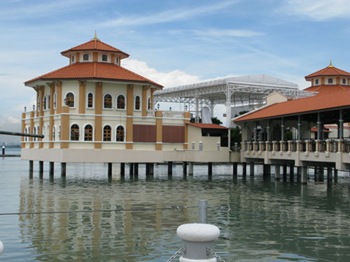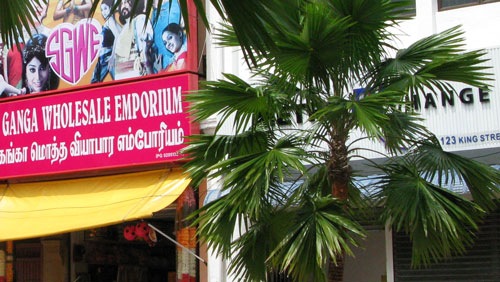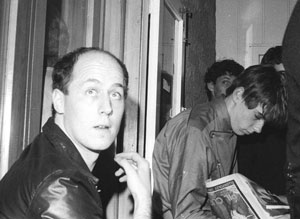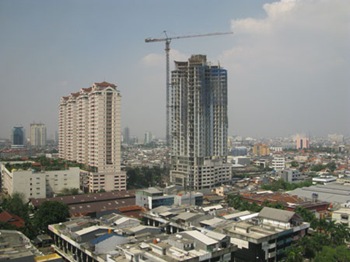 Of our two weeks on the road (almost), Jakarta was the highlight..simply because that was where the tethers were loosened...where I was allowed to indulge my desire to do what the others had been doing, and buy something for myself…Brigid sent me off to buy a travel iron.
Of our two weeks on the road (almost), Jakarta was the highlight..simply because that was where the tethers were loosened...where I was allowed to indulge my desire to do what the others had been doing, and buy something for myself…Brigid sent me off to buy a travel iron.
Not that I want a travel iron, mind, although they are handy wee things when on the road (Indonesian hotels get funny about supplying these in room even from room service), but I guess she felt that I would be happily satiated by its purchase…I’d want no more from the trip and stop complaining about the shoes or the very cool Chinese starred cap I’d wanted in Kuala Lumpur but been dissuaded from buying (you have a hat already…but you have a skirt already…that’s different..).
No, Jakarta had that extra something. *
*(the above of course is grossly unfair and I’d like to point out I got three shirts in Penang…and a road map in Kuala Lumpur)
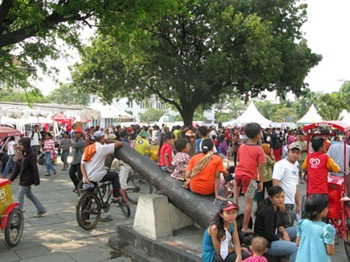 And thus it was appropriate that we arrived in Jakarta the day the big sales started and if any city is about malls and shopping, I guess Jakarta is it. And our first hotel was actually attached to a mall.
And thus it was appropriate that we arrived in Jakarta the day the big sales started and if any city is about malls and shopping, I guess Jakarta is it. And our first hotel was actually attached to a mall.
Yes, malls…we did a few. Not just in Jakarta but everywhere, but the Big Durian is the city of malls..some eighty they say. However, after you’ve wandered past half a dozen Gucci or Hugo Boss or Versace stores it’s hard to get too excited.
Jakarta always feels a little like a wasted opportunity. I’ve always felt that each time I’ve left, after I’ve shopped and eaten, and I've done that more than a few times sadly. So this time, I determined to do something more with my time.
I’d always wanted to check out the old port to the north so I pushed the idea over the huge breakfast at the Mulia (whence we had moved too...more Versace), and we hopped in a cab and said Sunda Kelapa please…the Maritime Museum. The driver hesitated. Are you sure? Yep…it is, after all, a museum and one of Jakarta’s oldest buildings. It’s an area, which some three hundred years ago, was one of the most 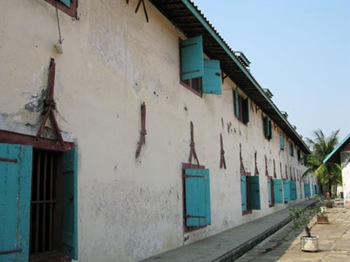 important bits of real estate in the world, from where the all powerful VOC ruled the vast wealth of the East Indies, and where the Portuguese traded with the Hindu kingdom of Pajajaran before that.
important bits of real estate in the world, from where the all powerful VOC ruled the vast wealth of the East Indies, and where the Portuguese traded with the Hindu kingdom of Pajajaran before that.
And thus I wanted very much to see it. Blake was keen but the others a little less so and as we rode north from Kota, they suggested we turn back from the slightly mean streets we were going through. But I was determined, and pretended I'd not heard, and onwards we went until we came to a stop in a fairly run down market square.
The driver asked a guy the directions and he smiled, gestured around and said that this was it. We looked around…sure there was an old cannon or two…but this was it?
It seems it was indeed. The guy we asked introduced himself…he was Trenggono and he was the custodian. Little, round and very cheerful, he was also a Professor in Indonesian History and offered to 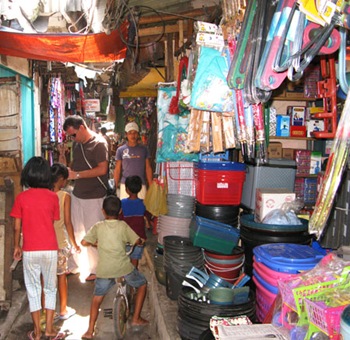 guide us. As in all things Indonesian there was no doubt a price involved somewhere but, hell, this was a real life Indonesian academic to take us through the oldest buildings in the oldest part of the biggest city in the 4th biggest nation in the world.
guide us. As in all things Indonesian there was no doubt a price involved somewhere but, hell, this was a real life Indonesian academic to take us through the oldest buildings in the oldest part of the biggest city in the 4th biggest nation in the world.
The Maritime Museum, or Museum Bahari to use its correct name, dates back to about 1650. Coincidently the book I was reading at the time contains a drawing of the area around the turn of the eighteenth century and the building is clearly evident as it is in this map of old Batavia. Used as both a warehouse over the years (including by the Japanese during WW2) and a fort, clearly this building has some historic importance, not only for the Indonesians, but also for the Dutch..and indeed the letters VOC are branded everywhere..on doors, on the wall and on the cannon. So it was fairly disappointing to see the state of disrepair it was in. Windows were falling off, walls crumbling and drains full of garbage. It may have lasted some 350 years but it’s time is short if something isn’t done, and the two governments are guilty of the gross neglect..surely the Dutch people are able to move past their guilt for their past sins in Indonesia and work with the Indonesian government to do something?
But for all that, it’s an incredible thing to stand in the triangular courtyard of a building that once operated as an axis for much of the world’s wealth some centuries back..and there was something about the fact that it’s restoration and transformation into a polished tourist centre had yet to happen that added to that feeling. And Trenggono was the perfect guide, funny, full of trivia and gruesome detail…the VOC were not only brutal but the roots of the corruption that plagues Indonesia today can be traced back to their reign and to the Dutch era.
Inside boats from around the Archipelago, old maps & drawings, various exhibits that had no or illegibly faded signage, and a series of storyboards telling the history of the area, filled the badly lit halls (partially because many of the bulbs had blown and not been replaced), and a bunch of young kids wandered around giggling at the crazy bulé visitors.
Outside in the street, locals slept next to more old cannons, one dated 1718. We walked with Trenggono north through the streets and shops that edged the fort and I asked him if these people were original Jakarta-ites. No, he said, these were not Betawi, but mostly immigrants from the outer islands who had come to Jakarta to seek their fortune, like generations before them who had moved here then moved on.
We wandered towards the harbour itself, through narrow alleyways built on wood over the VOC era canal to the sea. Kids came out to say hello and giggle again, and every now and then we’d glimpse a bunch more sitting in a dark furniture free room watching soccer on a small TV.
As we wound around the alley towards the open harbour, which was increasingly filled with garbage and trash, a series of bridges struck off over the canal. On one there was a hut with two guys collecting a Rp1000 toll. We asked and were told that the water supply was over there and the guys collecting the toll were the police. Nice.
Two Frenchmen passed us heading over the bridge..after something but I’m guessing it wasn’t water.
Trenggono offered us a boat trip around the harbour, but this historic waterway was so full of filth we demurred.... although kids could be seen swimming in it in the distance.
We then moved inland along the canal, past an old Dutch drawbridge, on to Fatahillah Square, the centre of old Kota..old Batavia, where the VOC Governor’s Mansion, also from the early 1700s, is now the Jakarta Museum. The cells underneath, used by both the Dutch and the Japanese, and not tall enough to stand in, and the execution post in the centre of the square, 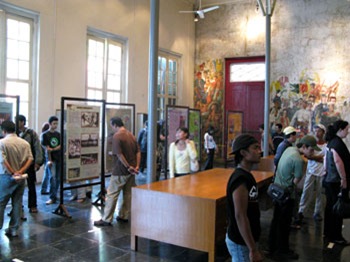 where the VOC and their successors used to, amongst other things, use horses to pull dissidents and insurgents apart, gave us more reason to think that given recent events in the Middle East, not much has changed in several hundred years.
where the VOC and their successors used to, amongst other things, use horses to pull dissidents and insurgents apart, gave us more reason to think that given recent events in the Middle East, not much has changed in several hundred years.
But the highlight of the old museum was far more contemporary. In one of the old buildings off the side of it’s courtyard Jakarta City had a Reformasi exhibition…two rooms which graphically and honestly portrayed the last ten years of Indonesian history, the ten years since the people of Indonesia, with no foreign assistance, cast off their own fairly brutal and murderous dictator. There were queues of people of all ages but particularly well representative of that large and growing very well educated post-98 grouping that is increasingly evident in Jakarta.
Trenggono’s point was that it was appropriate to have such an exhibition in a place like this as the dark years go back fairly continuously from 1998 back to the Dutch arrival and July 1998 was the first real glimmer of light, but the momentum since then has been largely unstoppable.
His point was well made.
The next day (ok we did a mall or two in between) Blake and I decided to extend our cultural excursion and visit the Suharto Museum which 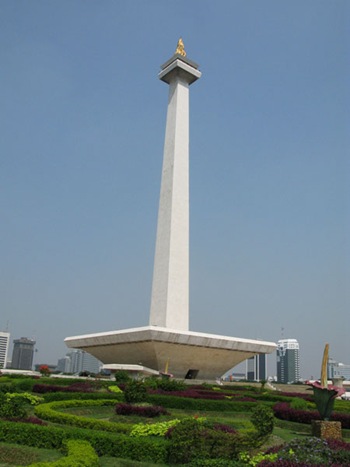 gathered together his gifts from around the world. Down by Taman Mini, its existence is due to the efforts of his wife who I guess thinks it sits as a tribute to the man’s greatness. However, to many of us I’d hazard that it’s more ugly than that and a statement of evidence as to those who turned an opportunistic blind eye to murder and corruption.
gathered together his gifts from around the world. Down by Taman Mini, its existence is due to the efforts of his wife who I guess thinks it sits as a tribute to the man’s greatness. However, to many of us I’d hazard that it’s more ugly than that and a statement of evidence as to those who turned an opportunistic blind eye to murder and corruption.
But, we, having checked the website (open every day) and trekked through the traffic for an hour or so discovered that it was Tutup setiap Hari Senin (closed every Monday). Oh..so we moved back north to our next destination…Monas. As Suharto’s Museum was a self constructed monument to his own greatness, so Monas was a self constructed monument to his failed predecessor, Sukarno, who promised so much but in the end delivered so little. The locals call it, in reference to his legendary bedroom antics, Sukarno’s Last Erection.
Wandering through the gates of Medan Merdeka Park, stepping over the ever-present litter that the park attendants seemed not to notice we walked, for what seemed like an hour in the glaring sun and probably was (we worked out what that little passenger train thing we ignored was for when we finally got there) until we found the entrance.
With typical illogical logic, you enter underground via a tunnel from a poorly signposted gate quite some distance away. Busloads of people, I imagine, from the provinces were flowing through to take the lift to the top of the 137 metre obelisk, to the gold, for want of a better word..knob.
We decided against that particular queue but went to go down to the Independence Museum underneath the thing. A National Park Guide approached us and offered to take us down. Warily, I asked him if there was a fee. No, he said, in very fractured English, it’s all gratis, and he led us down to the first room, a cavernous place, poorly lit, with huge murals and crests on the walls.
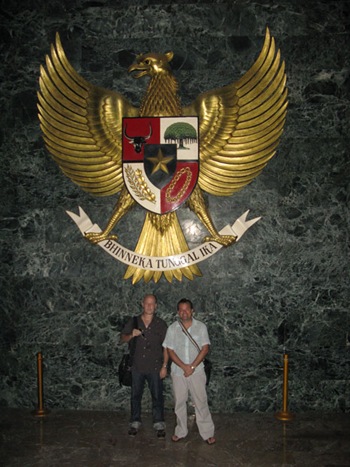 For the next ten minutes or so he explained the crest of Indonesia…17 feathers on the bottom to indicate 17th of August; white for purity etc…we nodded and had our photos taken. He then reached into his pocket and tried to sell us some cheap looking pin versions of said crest for far too much. I demurred and he then asked if we wanted to be taken to the actual museum. Since we’d understood little of what he’d said to date, I decided to pass and out came his hand…for a tip please. I passed him Rp3000 and he sneered and left.
For the next ten minutes or so he explained the crest of Indonesia…17 feathers on the bottom to indicate 17th of August; white for purity etc…we nodded and had our photos taken. He then reached into his pocket and tried to sell us some cheap looking pin versions of said crest for far too much. I demurred and he then asked if we wanted to be taken to the actual museum. Since we’d understood little of what he’d said to date, I decided to pass and out came his hand…for a tip please. I passed him Rp3000 and he sneered and left.
This government employed rogue, in his green Parks Dept uniform, seemed to be indicative of the gulf between this place, rooted firmly in the past, and the Reformasi exhibition looking hopefully ahead up there in old Kota. The point was made even clearer when we went down the stairs to basement level Indonesian history panoramas. They began a thousand years or so ago and continued around six walls, pausing only for a display on the monorail that Jakarta has been waiting on for most of the decade.
Apart from the, again, poorly lit dinginess of the place we found ourselves wandering around scratching our heads. The story shown here in the little windows ended in July 1998 and its half a dozen little story vignettes relating to the thirty two years prior to that bore no relation to recorded history. This was Indonesia’s own Orwellian era, when a totalitarian regime simply invented myths which were presented to the nation as facts (and indeed are still believed by many of the pre-Reformasi generations and I guess many of the Kampong folks we watched arriving here on their tour buses from some far flung part of Jawa or Sumatera). Pure fantasy invented to control and justify and it still exists, presented as historic fact, below Sukarno’s Last Erection.
The next day I scored my travel iron, found another mall or two, ate quite delicious Taiwanese Dim Sim in Senayan and got on a plane to Bali.

